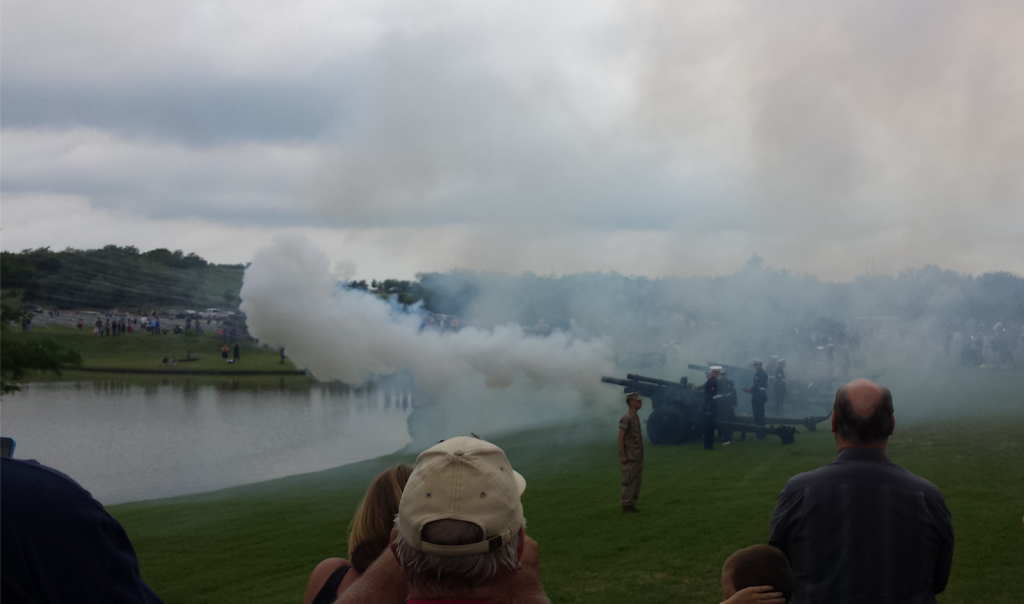Monday, my husband and I took the children and my mother (in town for a visit) out to the Dallas—Ft. Worth National Cemetery to attend the annual Memorial Day ceremony. It became obvious very quickly that we were first-timers … the car line stretched about a half-mile outside the gates, then another half-mile down the main road to a makeshift parking lot. (Note to self: next year, wake up early, bring chairs and snacks…)
We joined hundreds of others gathered to hear Texas Attorney General (and candidate for governor) Greg Abbott give the keynote speech, listen to the impressive bagpiper play Amazing Grace, watch the Knights of Columbus lay a large wreath, and be jolted by the 21-gun salute brought to us by a Marine division on three Howitzer guns.
Surrounding us were hundreds of perfectly lined grave markers bearing the name, rank, dates, awards and faith symbols of the military veterans who had died. Some died at a nice old age, but on many we read “KIA.” The saddest, to me, were those with a blank spot where the faith symbol was usually placed.
Did you know?
-
Burial in a national cemetery is open to all members of the armed forces and Veterans who have met minimum active duty service requirements and were discharged under conditions other than dishonorable.
-
 Eligible spouses, widows or widowers may also be eligible for burial, even if they predecease the Veteran. Their names are engraved on the back side of the marker. When the veteran dies, the stone is turned around so that the veteran’s information faces frontward.
Eligible spouses, widows or widowers may also be eligible for burial, even if they predecease the Veteran. Their names are engraved on the back side of the marker. When the veteran dies, the stone is turned around so that the veteran’s information faces frontward.
-
Reservists who die while on active duty or while performing training duty, or were eligible for retired pay, may also be eligible for burial.
-
 A veteran’s placement within the cemetery is based on date of death (not service or rank). So sections can be measured by the years on the death date, but the veterans may have served in any of the conflicts.
A veteran’s placement within the cemetery is based on date of death (not service or rank). So sections can be measured by the years on the death date, but the veterans may have served in any of the conflicts.
-
On each stone is engraved the deceased’s name, rank, birth and death dates, faith symbol, one chosen award if applicable, conflict arena (Korea, Iraq, Vietnam, WWII, etc), possibly their division, and a brief epitaph.
-
Memorial Day pays tribute to those who lost their lives in combat, whereas Veteran’s Day honors all veterans, living or dead.
-
 Memorial Day started a couple of years after the Civil War as “Decoration Day” when officials and family members would decorate the graves of fallen soldiers with flowers.
Memorial Day started a couple of years after the Civil War as “Decoration Day” when officials and family members would decorate the graves of fallen soldiers with flowers.
-
The National Moment of Remembrance encourages all Americans to pause wherever they are at 3 p.m. local time on Memorial Day for a minute of silence to remember and honor those who have died in service to the nation.
My husband and I reflected that, amazingly, we have not been personally touched by the death of an active-duty serviceman. We know and love many veterans—active, reserve, former, and retired—but none killed in action.
But many at the ceremony were there for very personal reasons. As the ceremony concluded and we all trudged back up the hill to our cars, then waited in the slow-but-friendly line that snaked out of the many makeshift parking lots, we noticed small clusters of people gathered here and there among the gravesites. Each stone had received a small American flag, but some sported patriotic red, white, and blue flower arrangements. Families and friends hugged, cried, tended to the mementos placed by their loved one’s name, told stories.
We spent the majority of our day off driving to/from and observing the respectful remembrance of our ultimate servants. Time well spent.
 Eligible spouses, widows or widowers may also be eligible for burial, even if they predecease the Veteran. Their names are engraved on the back side of the marker. When the veteran dies, the stone is turned around so that the veteran’s information faces frontward.
Eligible spouses, widows or widowers may also be eligible for burial, even if they predecease the Veteran. Their names are engraved on the back side of the marker. When the veteran dies, the stone is turned around so that the veteran’s information faces frontward. Memorial Day started a couple of years after the Civil War as “Decoration Day” when officials and family members would decorate the graves of fallen soldiers with flowers.
Memorial Day started a couple of years after the Civil War as “Decoration Day” when officials and family members would decorate the graves of fallen soldiers with flowers. 





No responses yet